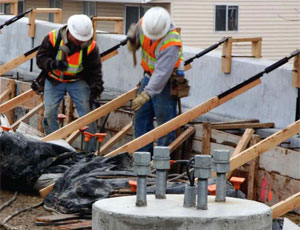...runs from Ogden, 40 miles north of Salt Lake City, to downtown, says Steve Meyer, the FrontRunner South project manager for UTA.

Meyer says the south project includes construction of more than 20 bridges, one of which is a flyover in the Sandy/West Jordan area over the existing I-15 freeway. In addition, right-of-way issues at the Salt Lake County/Utah County line have required extensive coordination with Union Pacific Railroad.
“We bought the rail corridor in 2002 from UP without a definitive concept on how to attack the Jordan Narrows area,” Meyer says. “The designers have done a fantastic job in developing the alignment and shifting Union Pacific’s railway while making space for future UP expansion.”
One major issue is the standard design and development and the overall right-of-way, says Kevin McFall, vice president of Alameda, Calif.-based Stacy-Witbeck, a general contractor working on FrontRunner South as well as the SLC Airport and West Valley City TRAX lines. “We’re going through eight cities and dealing with a multitude of private owners as well. It’s extremely challenging.
“We’ve excavated approximately a million cu yd of dirt through the Jordan Narrows canyon and moved the UP track to the east while we construct our track. We’ve got eight structures in that area to remove or rebuild, so it’s a significant amount of work.”
McFall says his crews are utilizing Geofoam for soil stabilization, in addition to using lightweight crushed lava rock fill to help mitigate possible resurfacing issues in the future.”
FrontRunner South and FrontRunner North are creating a major transit backbone for the entire Wasatch Front, Meyer says, “from Provo in the south to Pleasant View in the north. Close to 70% of the state’s population resides on that corridor.”
Meyer adds that contractors working on the job have been sensitive to difficulties with available cash flow.
“The contractors on this project understand we’re having economic challenges, and we’ve developed strategies for deferring payments and having them actually help us finance the project,” Meyer says. “It’s an advantage to contractors to have a steady workforce through the entire construction season.”
